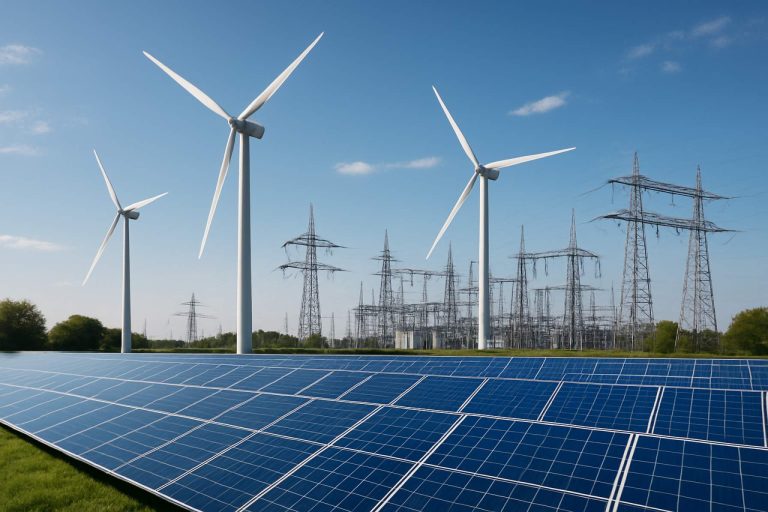
Decentralized Energy Networks in 2025: Market Dynamics, Technology Shifts, and Growth Projections. Explore Key Trends, Regional Leaders, and Strategic Opportunities Shaping the Next 5 Years.
- Executive Summary & Market Overview
- Key Technology Trends in Decentralized Energy Networks
- Competitive Landscape and Leading Players
- Market Growth Forecasts (2025–2030): CAGR, Revenue, and Volume Analysis
- Regional Analysis: Market Size, Adoption Rates, and Policy Drivers
- Future Outlook: Emerging Business Models and Investment Hotspots
- Challenges and Opportunities: Regulatory, Technical, and Market Barriers
- Sources & References
Executive Summary & Market Overview
Decentralized energy networks, also known as distributed energy systems, represent a transformative shift in the global energy landscape. Unlike traditional centralized grids, these networks rely on a diverse array of localized energy sources—such as solar panels, wind turbines, battery storage, and microgrids—to generate, store, and distribute electricity closer to the point of consumption. This model enhances grid resilience, reduces transmission losses, and empowers consumers to participate actively in energy markets.
The market for decentralized energy networks is experiencing robust growth, driven by technological advancements, policy incentives, and the urgent need for decarbonization. According to International Energy Agency, distributed energy resources (DERs) are expected to account for a significant share of new capacity additions through 2025, particularly in regions with ambitious renewable energy targets. The proliferation of smart meters, advanced inverters, and digital platforms is enabling seamless integration of these resources into existing grids.
In 2025, the global decentralized energy network market is projected to surpass $100 billion in value, with a compound annual growth rate (CAGR) exceeding 15% from 2022 to 2025, as reported by MarketsandMarkets. Key growth regions include North America, Europe, and Asia-Pacific, where supportive regulatory frameworks and declining costs of renewable technologies are accelerating adoption. For instance, the European Union’s “Fit for 55” package and the United States’ Inflation Reduction Act are catalyzing investments in distributed solar, battery storage, and demand response solutions.
- Residential and Commercial Adoption: Households and businesses are increasingly installing rooftop solar, energy storage, and smart energy management systems, contributing to grid flexibility and energy independence.
- Microgrids and Community Energy: Localized microgrids are gaining traction in remote areas and urban communities, providing reliable power and supporting grid stability during outages or peak demand.
- Peer-to-Peer Energy Trading: Digital platforms are enabling consumers to trade excess energy, fostering new business models and democratizing energy markets.
Despite rapid growth, challenges remain, including regulatory harmonization, cybersecurity risks, and the need for advanced grid management solutions. Nevertheless, decentralized energy networks are poised to play a pivotal role in the transition to a more sustainable, resilient, and consumer-centric energy future in 2025 and beyond.
Key Technology Trends in Decentralized Energy Networks
Decentralized energy networks, also known as distributed energy systems, represent a paradigm shift from traditional, centralized power generation toward localized, flexible, and often renewable energy sources. In 2025, several key technology trends are shaping the evolution and adoption of decentralized energy networks, driven by advances in digitalization, grid management, and consumer participation.
- Advanced Smart Grid Integration: The integration of smart grid technologies is enabling real-time monitoring, control, and optimization of distributed energy resources (DERs). Enhanced sensors, automated substations, and advanced metering infrastructure (AMI) are facilitating two-way communication between utilities and consumers, improving grid reliability and efficiency. According to International Energy Agency, global investment in smart grids is expected to surpass $100 billion in 2025, with a significant portion directed toward decentralized network capabilities.
- Peer-to-Peer (P2P) Energy Trading Platforms: Blockchain and distributed ledger technologies are enabling secure, transparent, and automated P2P energy trading. These platforms allow prosumers—consumers who also produce energy—to sell excess electricity directly to neighbors or local businesses. Projects like Powerledger and Energy Web Foundation are pioneering scalable solutions for decentralized energy marketplaces.
- AI-Driven Energy Management: Artificial intelligence and machine learning are being deployed to forecast demand, optimize energy dispatch, and manage distributed assets. AI-driven platforms can balance supply and demand in real time, reducing curtailment of renewables and enhancing grid stability. Wood Mackenzie reports that AI-enabled energy management systems are becoming standard in new decentralized network deployments.
- Growth of Microgrids and Virtual Power Plants (VPPs): Microgrids and VPPs aggregate and coordinate diverse DERs—such as solar, wind, batteries, and demand response—into unified, dispatchable resources. This trend is accelerating grid resilience and enabling communities to operate independently during outages. Guidehouse Insights projects the global VPP market will reach $4.5 billion by 2025.
- Edge Computing and IoT: The proliferation of IoT devices and edge computing is enhancing data collection and processing at the grid’s periphery. This supports faster decision-making and localized control, which are critical for managing the complexity of decentralized networks (Gartner).
These technology trends are collectively driving the transition toward more resilient, efficient, and consumer-centric energy systems, positioning decentralized energy networks as a cornerstone of the future energy landscape in 2025 and beyond.
Competitive Landscape and Leading Players
The competitive landscape of decentralized energy networks in 2025 is characterized by a dynamic mix of established energy conglomerates, innovative technology startups, and collaborative public-private partnerships. The sector is rapidly evolving, driven by the global push for energy transition, decarbonization, and the integration of distributed energy resources (DERs) such as solar, wind, battery storage, and demand response systems.
Leading players in this space include traditional utilities that are reinventing their business models, such as Enel and ENGIE, both of which have made significant investments in digital grid infrastructure and peer-to-peer energy trading platforms. These incumbents are leveraging their scale and regulatory expertise to deploy decentralized solutions at grid edge, often through subsidiaries or joint ventures.
Technology firms are also at the forefront, with companies like Siemens Energy and Schneider Electric providing advanced grid management software, microgrid controllers, and IoT-enabled devices that facilitate real-time energy optimization and market participation. Their platforms enable seamless integration of DERs and support the transition to more resilient, flexible energy systems.
Startups and scale-ups are driving innovation in blockchain-based energy trading, virtual power plants (VPPs), and community energy models. Notable examples include Power Ledger, which operates blockchain-enabled energy marketplaces, and Next Kraftwerke, a leading VPP operator in Europe. These companies are expanding their reach through partnerships with utilities and local governments, demonstrating the commercial viability of decentralized models.
The competitive environment is further shaped by regulatory frameworks and government initiatives, particularly in regions such as the European Union, where the EU Electricity Market Design encourages the participation of prosumers and energy communities. In the United States, the Federal Energy Regulatory Commission (FERC) has enacted policies to facilitate DER aggregation and market access, spurring competition among technology providers and aggregators.
Overall, the decentralized energy network market in 2025 is marked by intense competition, cross-sector collaboration, and a steady influx of capital from both strategic investors and venture funds. The leading players are those able to combine technological innovation, regulatory agility, and scalable business models to capture value in an increasingly distributed energy landscape.
Market Growth Forecasts (2025–2030): CAGR, Revenue, and Volume Analysis
The decentralized energy networks market is poised for robust growth between 2025 and 2030, driven by accelerating adoption of distributed energy resources (DERs), regulatory support for grid modernization, and increasing demand for resilient, low-carbon energy systems. According to projections by MarketsandMarkets, the global decentralized energy market is expected to register a compound annual growth rate (CAGR) of approximately 12% during this period. This growth is underpinned by expanding investments in microgrids, virtual power plants, and peer-to-peer energy trading platforms, particularly in regions with ambitious renewable energy targets.
Revenue forecasts indicate that the market could surpass $200 billion by 2030, up from an estimated $100 billion in 2025. This doubling in market size reflects both the scaling of existing decentralized energy projects and the proliferation of new business models enabled by digitalization and blockchain technologies. Notably, the Asia-Pacific region is anticipated to lead in revenue growth, fueled by large-scale deployments in China, India, and Southeast Asia, where electrification and grid reliability remain top priorities (International Energy Agency).
In terms of volume, the installed capacity of decentralized energy systems—including solar PV, wind, battery storage, and combined heat and power (CHP)—is projected to grow from approximately 350 GW in 2025 to over 700 GW by 2030. This surge is attributed to both utility-scale and behind-the-meter installations, with residential and commercial sectors accounting for a significant share of new capacity additions (BloombergNEF).
- Microgrids: Expected to achieve a CAGR of 13% through 2030, with North America and Europe leading in advanced microgrid deployments for critical infrastructure and community resilience.
- Peer-to-peer energy trading: Forecast to expand rapidly, especially in deregulated markets, as regulatory frameworks evolve to support transactive energy models.
- Virtual power plants (VPPs): Anticipated to see a CAGR of 15%, driven by the integration of distributed renewables and flexible demand response resources.
Overall, the 2025–2030 period will be characterized by accelerated market expansion, technological innovation, and evolving policy landscapes, positioning decentralized energy networks as a cornerstone of the global energy transition (Wood Mackenzie).
Regional Analysis: Market Size, Adoption Rates, and Policy Drivers
Regional dynamics play a pivotal role in shaping the decentralized energy networks market, with significant variations in market size, adoption rates, and policy frameworks across key geographies in 2025. The global market for decentralized energy networks is projected to surpass $80 billion by 2025, with Europe, North America, and Asia-Pacific emerging as the primary growth engines.
Europe leads in both market size and adoption rates, driven by ambitious climate targets and robust policy support. The European Union’s “Fit for 55” package and the European Commission’s electricity market reforms have accelerated the deployment of distributed generation, microgrids, and peer-to-peer energy trading platforms. Germany, the Netherlands, and Denmark are at the forefront, with decentralized networks accounting for over 25% of new capacity additions in 2025. Local energy communities and prosumer models are increasingly mainstream, supported by favorable feed-in tariffs and grid access regulations.
North America is witnessing rapid growth, particularly in the United States and Canada. The U.S. market is buoyed by state-level mandates, such as California’s Distributed Energy Resources Action Plan and New York’s Reforming the Energy Vision (REV) initiative, which incentivize microgrid deployment and grid modernization. According to the U.S. Energy Information Administration, decentralized energy resources are expected to contribute over 15% of total electricity generation in the U.S. by 2025. Canada’s focus on remote and indigenous communities has also spurred microgrid adoption, with government grants and public-private partnerships playing a crucial role.
Asia-Pacific is characterized by high growth potential, led by China, India, Japan, and Australia. China’s 14th Five-Year Plan emphasizes distributed solar and rural microgrids, with the National Energy Administration targeting over 50 GW of new distributed capacity by 2025. India’s decentralized energy push is driven by rural electrification and the Ministry of New and Renewable Energy’s support for mini-grids and off-grid solutions. Australia’s high rooftop solar penetration and innovative peer-to-peer trading pilots, supported by the Australian Renewable Energy Agency, further underscore the region’s leadership in adoption rates.
- Europe: Market size >$30B, adoption rate >25% of new capacity, strong policy drivers.
- North America: Market size ~$20B, adoption rate ~15%, state-led initiatives and incentives.
- Asia-Pacific: Market size >$25B, fastest growth, government-led rural and urban programs.
Policy frameworks, grid modernization investments, and local energy needs remain the primary drivers shaping regional trajectories in decentralized energy networks for 2025.
Future Outlook: Emerging Business Models and Investment Hotspots
The future outlook for decentralized energy networks in 2025 is shaped by rapid technological innovation, evolving regulatory frameworks, and shifting investment priorities. Decentralized energy networks—comprising distributed generation, peer-to-peer (P2P) energy trading, and microgrids—are poised to disrupt traditional utility models and create new business opportunities across the energy value chain.
Emerging business models are increasingly centered around digital platforms that enable prosumers (consumers who also produce energy) to trade surplus electricity locally. Blockchain-based P2P trading platforms are gaining traction, allowing for transparent, automated transactions and reducing reliance on centralized intermediaries. Companies such as Powerledger and LO3 Energy are piloting these models in various markets, demonstrating both technical feasibility and growing consumer interest.
Another promising model is the rise of community energy projects, where local stakeholders co-invest in renewable assets and share the benefits. These projects are supported by policy incentives in regions like the European Union, where the European Commission is actively promoting energy communities as part of its decarbonization strategy. In the U.S., states such as California and New York are fostering similar initiatives through regulatory support and funding.
Investment hotspots in 2025 are expected to cluster around regions with high renewable penetration, supportive policy environments, and advanced digital infrastructure. According to Wood Mackenzie, Asia-Pacific and Europe are leading in microgrid deployments and distributed energy resource (DER) integration, while North America is seeing significant venture capital inflows into energy tech startups. The global market for distributed energy resources is projected to exceed $400 billion by 2025, with strong growth in solar PV, battery storage, and smart grid technologies (BloombergNEF).
- Peer-to-peer energy trading platforms are expected to scale, especially in urban areas with high rooftop solar adoption.
- Microgrids will proliferate in remote and underserved regions, providing resilience against grid outages and supporting energy access goals.
- Corporate and institutional investors are increasingly targeting decentralized energy assets for their stable returns and ESG alignment (International Energy Agency).
In summary, 2025 will see decentralized energy networks move from pilot projects to mainstream adoption, driven by innovative business models and concentrated investment in regions with enabling conditions.
Challenges and Opportunities: Regulatory, Technical, and Market Barriers
Decentralized energy networks (DENs) are transforming the global energy landscape by enabling localized generation, storage, and distribution of electricity. However, their widespread adoption in 2025 faces a complex interplay of regulatory, technical, and market barriers, alongside significant opportunities for innovation and growth.
Regulatory Barriers and Opportunities: The regulatory environment remains fragmented, with many jurisdictions lacking clear frameworks for integrating decentralized assets into existing grids. Issues such as interconnection standards, grid access, and compensation mechanisms for distributed energy resources (DERs) persist. For example, in the European Union, the implementation of the Clean Energy for All Europeans package has advanced regulatory clarity, but national-level disparities still hinder cross-border energy sharing and market participation European Commission. In the United States, state-level policies vary widely, affecting the scalability of community solar and microgrid projects National Renewable Energy Laboratory. Nonetheless, evolving regulations that support peer-to-peer trading and grid flexibility present new opportunities for DENs to participate in ancillary services and capacity markets.
Technical Barriers and Innovations: Integrating high shares of distributed generation poses challenges for grid stability, interoperability, and cybersecurity. Legacy grid infrastructure is often ill-equipped to handle bidirectional power flows and real-time balancing required by DENs. Advanced digital platforms, such as blockchain-based energy trading and AI-driven grid management, are emerging to address these issues International Energy Agency. However, the lack of standardized communication protocols and data privacy concerns remain significant hurdles. Investment in smart grid technologies and robust cybersecurity frameworks is critical to unlocking the full potential of decentralized networks.
- Market Barriers: Traditional utility business models, which rely on centralized generation and volumetric sales, often conflict with the decentralized paradigm. Market access for small-scale producers is limited by high transaction costs and insufficient aggregation mechanisms. However, the rise of energy communities and virtual power plants is beginning to create new revenue streams and business models, enabling prosumers to monetize flexibility and storage assets Bloomberg.
In summary, while decentralized energy networks face significant regulatory, technical, and market barriers in 2025, ongoing policy reforms, technological advancements, and innovative market structures are steadily creating pathways for their broader adoption and integration.
Sources & References
- International Energy Agency
- MarketsandMarkets
- Powerledger
- Energy Web Foundation
- Wood Mackenzie
- Enel
- Siemens Energy
- Next Kraftwerke
- EU Electricity Market Design
- BloombergNEF
- European Commission
- National Energy Administration
- Ministry of New and Renewable Energy
- Australian Renewable Energy Agency
- National Renewable Energy Laboratory



